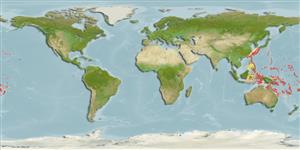>
Eupercaria/misc (Various families in series Eupercaria) >
Lutjanidae (Snappers) > Apsilinae
Etymology: Paracaesio: Greek, para = the side of + Latin, caesium = bluish grey (Ref. 45335).
Environment: milieu / climate zone / depth range / distribution range
Ecología
marino demersal; rango de profundidad 100 - 310 m (Ref. 9821), usually 125 - 250 m (Ref. 82366). Tropical; 32°N - 26°S, 116°E - 167°W (Ref. 55)
Western Pacific: Samoa to Taiwan and Singapore and from the Ryukyu and Ogasawara islands southward to New Caledonia and northeastern Australia.
Tamaño / Peso / Age
Maturity: Lm ? range ? - ? cm
Max length : 60.0 cm SL macho / no sexado; (Ref. 9821)
Espinas dorsales (total) : 10; Radios blandos dorsales (total) : 10; Espinas anales: 3; Radios blandos anales: 8. Eye large, about 3.6 times in head length. Interorbital space convex. Large specimens developing a hump on forehead. Lower jaw protruding slightly. Maxilla scaled. Scale rows on back parallel to lateral line. Pectoral fins long, reaching level of anus. Back and upper sides brown; remainder of head and body silvery white with 4 broad vertical bars on upper side. Fins grayish, whitish or slightly yellowish.
Adults are found over rocky bottoms. Marketed fresh.
Life cycle and mating behavior
Maturities | Reproducción | Spawnings | Egg(s) | Fecundities | Larva
Allen, G.R., 1985. FAO Species Catalogue. Vol. 6. Snappers of the world. An annotated and illustrated catalogue of lutjanid species known to date. FAO Fish. Synop. 125(6):208 p. Rome: FAO. (Ref. 55)
IUCN Red List Status (Ref. 130435)
Threat to humans
Harmless
Human uses
Pesquerías: escaso valor comercial
Herramientas
Special reports
Download XML
Fuentes de Internet
Estimates based on models
Preferred temperature (Ref.
123201): 13.2 - 23.4, mean 19.2 °C (based on 97 cells).
Phylogenetic diversity index (Ref.
82804): PD
50 = 0.5039 [Uniqueness, from 0.5 = low to 2.0 = high].
Bayesian length-weight: a=0.01288 (0.00649 - 0.02558), b=3.06 (2.88 - 3.24), in cm total length, based on LWR estimates for this species & (Sub)family-body (Ref.
93245).
Nivel trófico (Ref.
69278): 4.0 ±0.66 se; based on food items.
Generation time: 7.0 ( na - na) years. Estimated as median ln(3)/K based on 2
growth studies.
Resiliencia (Ref.
120179): Bajo, población duplicada en un tiempo mínimo de 4.5-14 años (Preliminary K or Fecundity.).
Fishing Vulnerability (Ref.
59153): Moderate to high vulnerability (54 of 100).
Nutrients (Ref.
124155): Calcium = 85.2 [32.1, 174.5] mg/100g; Iron = 0.891 [0.478, 1.522] mg/100g; Protein = 18.2 [16.4, 19.9] %; Omega3 = 0.262 [0.156, 0.449] g/100g; Selenium = 76.5 [42.4, 147.8] μg/100g; VitaminA = 21 [7, 69] μg/100g; Zinc = 0.917 [0.603, 1.345] mg/100g (wet weight);
